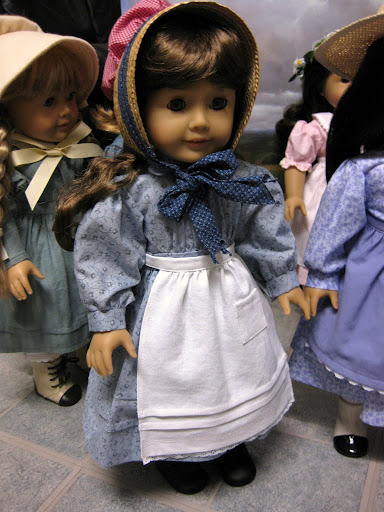Supersizers Go Regency is a historically accurate journey into the food and culture of regency England. So it might be inappropriate for kids and those adults who are prudish and squeamish. I just *love* this show though. It's hilarious. My favorite lines:
Sue is flopped on the ground, holding the leg of a military officer as he tries to escape, dragging her along the floor. Desperate Sue: "I *will* accept your proposal!"
Giles: "Fulfilling a lifelong ambition, I am a regency dandy." Hop, skip.
Giles: "I will be foppishly gambling my inheritance at the gaming tables."
To paraphrase the narrator...If you are a patriot, you do not drink claret, made by the fiendish French!
What are your favorite lines or parts?
Here are the other videos:
Part 2
Part 3
Part 4
Part 5
Part 6
A blog about American Girl, history, and miniature furniture, food, and fashion.
Friday, July 23, 2010
Sunday, July 18, 2010
Pioneer Dresses by Terristouch
I thought I should separate this post from my reflection on buffalo.



(Molly is modeling a blue dress on the left by Terristouch.)
(Molly is modeling a blue dress on the left by Terristouch.)
Friday, July 16, 2010
Where the Buffalo Roamed
Kirsten stories were set in Minnesota in the 1840s, and her encounters with Native Americans were always positive and gentle. She even makes friends with a little girl from a local tribe.
I did take a Native American History class in college. There were primary sources we read where white settlers had ambivalent and even positive opinions of indigenous populations. But I just never was able to get into the history of Western expansion. It was just so disturbing, reading about all the violent and tragic confrontations between settlers, the American army, and Native American tribes. But I was struck by the idea that what finally broke tribes like the Sioux, was the federal government encouraging army commanders, railway companies, sportsmen, etc to hunt the buffalo to near extinction. The nomadic Plain Indians followed the buffalo herds and used every piece of the animals to survive. On the other hand, many white Americans hunted the buffalo just for their pelts or for sport, and often left the rest of the carcass to rot, wasting the resource. Army commanders purposely, hoping to drive the Sioux and other tribes off valuable land and deprive them of their key resource, killed thousands upon thousands of buffalo. In just three years, in the early 1870s, 9 million buffalo were killed. The drastic thinning of buffalo herds from millions to a few thousand eventually forced Native Americans into the reservation system, which often led to lost identity and a host of other problematic social issues (e.g. alcoholism, depression).
I did take a Native American History class in college. There were primary sources we read where white settlers had ambivalent and even positive opinions of indigenous populations. But I just never was able to get into the history of Western expansion. It was just so disturbing, reading about all the violent and tragic confrontations between settlers, the American army, and Native American tribes. But I was struck by the idea that what finally broke tribes like the Sioux, was the federal government encouraging army commanders, railway companies, sportsmen, etc to hunt the buffalo to near extinction. The nomadic Plain Indians followed the buffalo herds and used every piece of the animals to survive. On the other hand, many white Americans hunted the buffalo just for their pelts or for sport, and often left the rest of the carcass to rot, wasting the resource. Army commanders purposely, hoping to drive the Sioux and other tribes off valuable land and deprive them of their key resource, killed thousands upon thousands of buffalo. In just three years, in the early 1870s, 9 million buffalo were killed. The drastic thinning of buffalo herds from millions to a few thousand eventually forced Native Americans into the reservation system, which often led to lost identity and a host of other problematic social issues (e.g. alcoholism, depression).